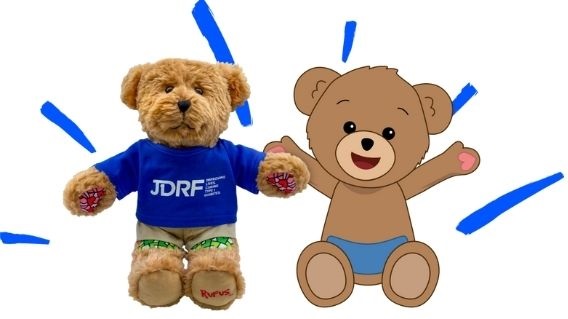
He’s cute. He’s fuzzy and cuddly. And thanks to the Breakthrough T1D-Beyond Type 1 Alliance, Rufus, the Bear with Diabetes® has gone through a major upgrade!
All of this on the heels of Rufus’ 25th birthday.
What’s New?
Rufus is now a technologically advanced, interactive bear with his own companion mobile application!
You could say this is “Rufus, 2.0.”
Made possible by the Breakthrough T1D-Beyond Type 1 Alliance, the new Rufus and app features educational content and fun games to teach children about life with diabetes.
The newly redesigned bear now features special patches not only to teach children and their caregivers where insulin doses can be delivered to the human body, but also so that children can interact with Rufus in Rufus’ world on the app “Rufus the Bear with Diabetes.”
Through the app, children can help Rufus manage his diabetes and gain hands-on practice with diabetes management essentials like counting carbs, monitoring blood sugar, and dosing with insulin.
“Rufus has been one of the most requested support items for children with T1D,” said Kristin Horowitz, Senior Manager of Community Engagement at Breakthrough T1D. “Rufus’ new upgrades now match the most up-to-date T1D management options and will help so many newly diagnosed families easily learn the basics of day-to-day diabetes care in a fun way.”
More App Facts
In the app, users will get to utilize Rufus’ virtual diabetes toolkit, which includes a glucometer, insulin pen, pump, and a CGM; guidance on making healthy choices in the kitchen and information about the impact of carbs; and how-tos for identifying hidden sources of carbs.
But the fun doesn’t stop there! Users can follow the adventures of Rufus as he trains for the All-Star Game in 21 interactive e-books on the app.
Rufus is available free of charge to newly diagnosed families through the Bag of Hope program.
The app Rufus the Bear with Diabetes is available on Google Play, the App Store for iPhone and iPad, and the Amazon Appstore.
Rufus’ Roots
Rufus’ story begins in the Chicago suburb of Lake Zurich in 1994 when a 3-year-old boy named Brian was diagnosed with T1D. During Brian’s hospitalization, the staff gave him a coloring book to learn about his new diagnosis. “When you go to the hospital,” said Carol, “You hope to come home cured.” Unfortunately, this is not the case with T1D.
Brian’s mom, Carol Cramer, a classically trained musician, and stay-at-home mom, felt that there had to be a better way to educate her son. She hoped to come up with something that could comfort Brian and help him understand his new world.
Months passed and Carol found herself struggling with anxiety and depression¾she felt alone and scared. “You can’t do anything to get [your child] totally better, and you go through so many emotions, and you feel so much guilt,” says Carol. Like so many type 1 parents, Carol wondered if she had done something to cause her son’s diabetes.
Then one day in June, 1996, Carol awoke with an idea and knew exactly what she needed to do.
She went to the store to buy the perfect-sized teddy bear. She used a cereal box to cut out templates for felt patches that she sewed onto the teddy’s arms, thighs, buttocks, and stomach. A red heart adorned the chest to represent blood and blood glucose. Carol dressed the bear in a Chicago Bulls outfit. Rufus had come to life.
Read more about Rufus’ origins and how he became a Breakthrough T1D icon, and see photos of Rufus through the years in the Breakthrough T1D Illinois Chapter blog celebrating Rufus’ birthday.
A Bear with Clinical Clout
As stated above, Rufus is more than a cute and fuzzy friend. He’s an effective educator who can help children with T1D and their caregivers adjust to their new day-to-day.
According to a 2018 study published in the journal SAGE Open Nursing as many as 19% of children ages 4 to 6 years and about 11% of children ages 10 to 11 years could be diagnosed with needle phobia (Trypanophobia).
One recommended strategy for helping children overcome needle fears and or fears of pain from needles is through play. Another study, published in the journal Pain Research and Management, found that an educational intervention involving a “teddy bear clinic” reduced children’s expectations of pain during needle procedures.
Aaron Horowitz, Co-Founder and CEO of Sproutel, and creator of the Jerry the Bear and the new “Rufus 2.0,” has more to say on the value of play therapy: “Children naturally use imaginative play to learn and to understand the world around them. For children with diabetes we’ve observed that they often pretend-play medical procedures with their stuffed animals. Rufus 2.0 brings this pretend-play to life in an interactive and virtual world. Engaging children directly in their care, through tools like Rufus, can empower them with a sense of control and can help alleviate some of the stress of diabetes management in the home.”
“When I put together the first Rufus bear I wanted to provide my son with an object of comfort to help navigate his new normal,” said Rufus’ creator Carol. “But little did I know through connecting with Breakthrough T1D and other T1D families there was a widespread need for a comforting companion.”
“Over the years, I have seen Rufus help families through the hardest times,” she added. “And I am extremely proud of the continued work of Breakthrough T1D to ensure so many children receive their new diabetes best friend.”